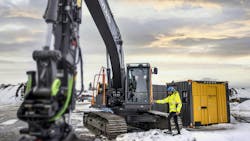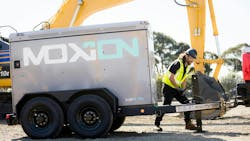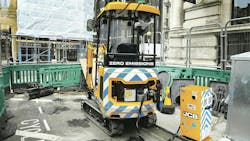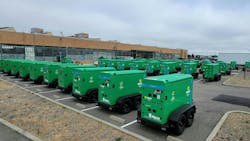As managers are challenged by their firms to set sustainability goals, it’s inevitable that electric equipment has a role in the discussion.
It’s also inevitable that questions will arise about charging. Two of the biggest: Is there enough juice on site to support electric equipment? What about charging out in the field when no power source is nearby?
OEMs have been working on charging solutions almost as long as they’ve been developing the equipment itself and partnering with (or buying) battery providers. Some are already commercially available.
The nation’s major rental companies have been purchasing the manufacturers’ electric equipment and developing charging hardware of their own to position themselves as turnkey solutions.
Read also: United Rentals Launches New Fleet Emissions Management Platform
Volvo Construction Equipment has arguably led the industry in the push toward electric, not only in marketing, but also by fielding the most electric models so far.
Moxion Pilots Charging System
Moxion and Komatsu partnered on a pilot at the construction site of Moxion’s new gigafactory. The mobile battery unit was onsite to charge Komatsu’s 20-ton electric excavator.
The excavator was able to work for 8 hours without needing to be charged. If it were to be used for one 40-hour week, it would save 98 gallons of diesel fuel and avoid 2,200 pounds of emissions.
Moxion has also held demos with Volvo’s EC220 all-electric excavator and with Bigge, a crane rental company, to power its first-ever electric crane with 8 hours of energy.
The Moxion MP-75 is a mobile battery built to replace diesel generators. It provides 75kW of power and over 600kWh of energy.
On the charging front, Volvo has partnered with Beam Global to allow Volvo dealers to bundle charging systems with a purchase of electric equipment.
Beam provides products for electric vehicle charging, energy storage, energy security, and outdoor media. The partnership involves the company’s EV ARC off-grid charging systems.
This joint offering enables construction sites to rapidly deploy EV charging, without the requirement for electrical work, utility grid connections, or fossil fuel generators, to power zero-emissions construction equipment that runs on the sun and does not generate a utility bill, according to Beam.
The system looks a bit like a carport, with the solar panel reaching slightly higher than the electric machines.
“The construction industry has the opportunity to future-proof its business against noise, carbon emissions regulations, and volatile fossil fuel costs by adopting electric machines,” said Beam Global CEO Desmond Wheatley in a prepared statement about the deal.
“The Volvo CE line of zero-emissions construction equipment can now be charged with a zero-emissions energy source provided by the EV ARC,” said Ray Gallant, Volvo CE VP of product management and productivity.
“Beam Global shares our vision to electrify mobility worldwide, a critical step towards mitigating climate change and reducing noise and air pollution. The construction industry is ready for an energy transition that reduces emissions and improves machinery’s performance, longevity, and usability,” Gallant said.
The EV ARC system is designed to be set up and ready to use in minutes. It is fully autonomous, meaning it generates, stores, and delivers electricity independent of the grid. Whether the project is in a remote nature preserve or a densely populated city with strict zoning rules, the company says the solar-powered EV ARC can be deployed without any electrical work or permitting.
Volvo has also partnered with another company to address off-the-grid situations. A deal with Portable Electric provides Voltstack chargers. The Voltstack 30k Level 2 charger can boost charging, allow for temporary charging stations, and provide recharging services. It is silent and emission free and can also be hybridized with a diesel generator to provide off-grid power.
Volvo also has agreements with Benning Fast Chargers specifically for 48V lithium-ion battery machines, and Heliox for mobile 50kW chargers that power 600V machines like Volvo’s EC230 Electric hydraulic excavator. The FreeWire Boost Charger 150 is also available. It’s a battery-integrated DC fast charger for 600V machines.
Read also: Skanska Deploys Electric Roller in Pilot
JCB has developed a Universal Fast Charger for construction and landscaping contractors with the need for quick turnaround times when using the company’s battery electric equipment. Compatible with most of JCB’s zero-emissions, E-Tech machines, the stand-alone Universal Fast Charger draws 440-volt/three-phase input from a hard-wired power source or generator and uses it to recharge the batteries on compatible machines in as little as two hours or less.
The free-standing unit has a lift eye for portability, an IP54 rated enclosure, and an optional lockable Charge Guard cover suitable for outdoor exposures.
For contractors or jobs that have fewer time constraints, all JCB battery-electric machines (except for the Teletruk) come standard with built-in onboard chargers. These can be energized with 110V or 220V current, using shore power at the job site, generators, power outlets at the shop, or regular household current. Going from a low battery charge to fully charged system using the onboard charging takes about 8 to 16 hours.
“This gives customers the ability to choose the input charging voltage based on charge time requirements and provides flexibility for job sites with different power source availability,” said Lee Tice, JCB product manager.
To use the onboard charging system, plug one end of the JCB-supplied charging lead (similar to an extension cord but with different ends) into the power source and the other end into the machine’s onboard charging port and start recharging. The 110V and 220V onboard charging ports have 3-pin connections. The rapid chargers have 5-pins: 2 main and 3 CANBUS.
“With 110V or 220V power sources, our machines can be topped up or charged in the middle of the workday for additional runtime or charged overnight or for extended periods of time without any harmful effect to the battery,” Tice said. “But if you have double shifts or other schedule demands, the JCB Fast Charger can take that same machine from zero battery charge to full in two hours or less.”
All compatible JCB machines come Fast Charger ready. This is beneficial if the customers’ usage requirements change after purchase of the machine, allowing them to add the Fast Charger to their fleet later, according to Tice.
United Rentals has introduced JuiceBox mobile power generators to its equipment rental fleet.
The generators can be powered by propane or natural gas, providing a low-emissions alternative to diesel machines to charge electric vehicles, tools, and other equipment.
United Rentals acquired the generators from Evergreen Mobile Power. They feature a much lower operating cost than diesel generators, up to 40%, according to United. The generators use propane, which produces 17% lower greenhouse gas emissions than diesel machines. With a compact footprint of 50x50x54 inches, the generators deliver instant power up to 20 kW. They can be linked together to address higher power demands.
The generators are equipped with dual interchangeable and removable electrical panels, making it possible to customize the generators to various power needs. In addition to the environmental benefits, the generators run much quieter than traditional generators.
“Diesel engine emission regulations are driving companies to look for new options they can deploy,” said Dan Gribbell, PHVAC region sales and marketing director, United Rentals. “Adding JuiceBox generators to our fleet provides another way we are helping our customers create lower-emission worksites without compromising safety or productivity. With low operations costs and greenhouse gas emissions, the JuiceBox provides a smarter choice for the environment and a customer’s wallet.”
United Rentals has also added mobile microgrid battery power to its fleet of rental equipment. Hipower EHR solar battery generators pair a battery energy storage system with power provided by integrated photovoltaic solar panels and a propane generator.
The unit has a 5.0 kW peak solar array and extendable panels. Converted energy from the sun is stored in the system’s batteries. The unit also has a 45kVA generator that provides power running on propane.
The hybrid power solution minimizes generator run time by storing energy in the battery system and running on battery power whenever possible. The smart grid controller turns on the generator when the batteries run low due to reduced sunlight or increased demand. Once sufficient battery charge is reached through sunlight and/or generator, the controller turns the generator off.
The solar battery generator can be mounted on a 20x8-foot trailer or a skid for transport to and from job sites. The microgrid has many job site applications, including a charging station for equipment or electric tools and trucks. It can also power temporary office spaces such as container offices, mobile office trailers, guard shacks, restroom trailers, and trailer complexes. For small to mid-size job sites, the generator could potentially serve as the single source of power, depending on load requirements, United said.
Sunbelt Rentals offers its Battery Energy Storage System (BESS) for job site charging.
The BESS is an energy storage solution that collects and stores energy from the grid or a generator and then discharges it later to provide a source of electricity when needed. BESS units can have a wide range of power and storage capacities, particularly for construction sites and job site trailers.
How Sunbelt's BESS works
When the grid or generator is supplying power to the site, excess power is used to recharge the batteries. The BESS inverter converts the stored DC energy into AC energy. When the BESS is disconnected from the grid or the generator is switched off, the energy load is supplied by the BESS. The changeover is engineered to be seamless, and the hybrid quietly provides power.
The generator restarts when batteries are depleted or when the energy load exceeds what the unit can support.
The systems are designed to maximize both kilowatts and kilowatt hours. If used to reduce utility charges during peak hours, the BESS can efficiently charge many times over short durations of time. If needed for backup power, it is designed to discharge over a longer period. Systems are rated for power capacity (measured in kW) and energy capacity (measured in kWh).
Sunbelt says its system produces power needed for projects without running diesel 24/7, which maximizes the load efficiency of generators; reduces diesel fuel consumption (and cost) typically by 40% to 60%, and as much as 95% depending on the application; boosts generator power up to 60 kW for start-up demand; and reduces generator run times by as much as 90%.
It is also said to reduce greenhouse gas (GHG) emissions (CO2) by 83%.
About the Author
Frank Raczon
Raczon’s writing career spans nearly 25 years, including magazine publishing and public relations work with some of the industry’s major equipment manufacturers. He has won numerous awards in his career, including nods from the Construction Writers Association, the Association of Equipment Manufacturers, and BtoB magazine. He is responsible for the magazine's Buying Files.




